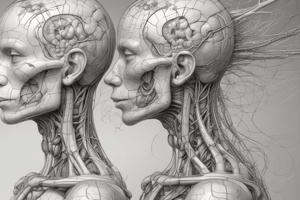Podcast
Questions and Answers
What does the term 'superior' denote in anatomical direction?
What does the term 'superior' denote in anatomical direction?
- A structure is closer to the surface of the body
- A structure is relatively high or upper in the body (correct)
- A structure is closer to the center of the body
- A structure is closer to the feet
What is the term for the same side of the body?
What is the term for the same side of the body?
- Ipsilateral (correct)
- Contralateral
- Bilateral
- Lateral
What denotes the relative distances of structures from the surface of the body?
What denotes the relative distances of structures from the surface of the body?
- Medial and lateral
- Superior and inferior
- Anterior and posterior
- Superficial and deep (correct)
What position is the body in when lying on its back?
What position is the body in when lying on its back?
What is the opposite of ipsilateral?
What is the opposite of ipsilateral?
What determines the relative distance of a structure from the center of an organ or cavity?
What determines the relative distance of a structure from the center of an organ or cavity?
What is the term for lying face downward?
What is the term for lying face downward?
What does the term 'inferior' denote in anatomical direction?
What does the term 'inferior' denote in anatomical direction?
What describes the relative distance of a structure from the center of an organ or cavity?
What describes the relative distance of a structure from the center of an organ or cavity?
What is the term for opposite sides of the body?
What is the term for opposite sides of the body?
Flashcards are hidden until you start studying
Study Notes
Anatomy Objectives
- To develop a distinct nomenclature for describing areas of the body
- To provide orientation when describing parts of human anatomy
- To distinguish different movements of the body
Basic Anatomy
- Anatomy is the science of the structure and function of the body
- Clinical anatomy studies the macroscopic structure and function of the body as it relates to medicine and other health sciences
- Basic anatomy studies the minimal amount of anatomy necessary for understanding the overall structure and function of the body
Anatomical Position
- The anatomical position is a standard reference point for describing the human body
- In this position, the body is erect, eyes face forward, arms are by the sides with palms facing forward, and legs are together with feet directed forward
Planes of the Body
- Median sagittal plane: a vertical plane passing through the center of the body, dividing it into equal right and left halves
- Paramedian planes: planes parallel to the median plane
- Sagittal plane: divides the body into left and right halves
- Frontal (coronal) planes: imaginary vertical planes at right angles to the median plane, dividing the body into anterior and posterior parts
- Horizontal (transverse) planes: at right angles to both the median and coronal planes, dividing the body into superior and inferior parts
Terms of Orientation and Direction
- Anterior: towards the front of the body
- Posterior: towards the back of the body
- Medial: towards the median plane of the body
- Lateral: away from the median plane of the body
- Proximal: closer to the roots of the limbs
- Distal: farther from the roots of the limbs
- Superficial: closer to the surface of the body
- Deep: farther from the surface of the body
- Internal: inside an organ or cavity
- External: outside an organ or cavity
- Ipsilateral: on the same side of the body
- Contralateral: on opposite sides of the body
Body Positions
- Supine position: lying on the back
- Prone position: lying face downward
Studying That Suits You
Use AI to generate personalized quizzes and flashcards to suit your learning preferences.



